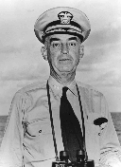|
 Vice Admiral Thomas Cassin Kinkaid had had a distinguished naval career when he took command of the United States Seventh Fleet, also known as MacArthur’s Navy. The Seventh Fleet had the responsibility to transport MacArthur’s forces as the mercurial general directed the highly successful campaign to capture the huge island of New Guinea. Vice Admiral Thomas Cassin Kinkaid had had a distinguished naval career when he took command of the United States Seventh Fleet, also known as MacArthur’s Navy. The Seventh Fleet had the responsibility to transport MacArthur’s forces as the mercurial general directed the highly successful campaign to capture the huge island of New Guinea.
The Japanese had invaded New Guinea during the early days of the Pacific War and captured almost all of it with exception of the island’s southeast corner which contained the only town of any consequence on that island, Port Moresby. When MacArthur landed in Australia after his harrowing escape from the Philippines, he dedicate all further efforts to defend Australia by attacking the Japanese on New Guinea. However, the Japanese had established formidable bastions along New Guinea’s northern coast. MacArthur made the correct military decision to bypass the powerful Japanese positions by launching numerous amphibious invasions on undefended locations, thus leaving thousands of Japanese troops totally isolated to “wither and die on the vine.” 
All these amphibious operations required a powerful naval force that could not be supplied directly by the American Pacific Fleet under the command of Admiral Chester Nimitz. So, the Seventh Fleet was created to provide the naval support needed to successfully carry out MacArthur’s ambitious amphibious incursions in the northern Solomon Islands and on New Guinea. The Seventh Fleet, despite lacking the significant naval resources of the Pacific Fleet, carried out their assigned tasks with distinction, bravery, and overwhelming success.
When the Americans started the planning for the invasion of the Philippines, it became clear that the vitally critical invasion force required overwhelmingly powerful naval forces. Therefore, both the Third Fleet and MacArthur’s navy would be needed to deliver a blow of sufficient force to guarantee success. Thus the Seventh Fleet was expanded to include not only a powerful bombardment force of battleships, cruisers, and destroyers but vast array of landing craft, supply ships, and minesweepers. 
Kinkaid was the ideal commander for the expanded Seventh Fleet since he had successfully demonstrated that he could effectively work under MacArthur’s command and could carry out highly complex amphibious operations. And the American landings of Leyte would the greatest invasion in the Pacific to that date.
However, the naval commands at Leyte was divided with Kinkaid under MacArthur’s command the Third Fleet commanded by Halsey under Nimitz's command. When the Imperial Japanese Fleet arrived in Philippine waters, the Americans’ ability to have a coordinated naval response became severely impaired. The lack of a single naval commander would result climactic Battle Off Samar. 
|
